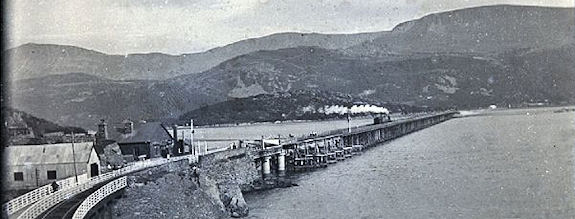
Britain's longest wooden railway bridge and the longest viaduct in Wales
Barmouth Station, Station Approach, Barmouth, Gwynedd, LL42 1LS
The Barmouth Bridge (Welsh: Pont Abermaw) is a single-track largely wooden railway viaduct that crosses the estuary of the Afon Mawddach river on the coast of Cardigan Bay between Morfa Mawddach and Barmouth in Gwynedd, Wales. A footbridge is incorporated on the landward side and pedestrians can walk by the side of the track across the river on payment of a toll of 70 pence (cycles 30 pence extra). The distance is about 900 m. The viaduct carries the Cambrian Line, the main line of the former Cambrian Railways, which runs from Shrewsbury, England to Pwllheli.
The bridge was built by the Aberystwyth and Welsh Coast Railway and opened in 1867, master-minded by Thomas Savin, a Welsh entrepreneur. Construction was difficult due to the strong currents and two men were drowned. As built, it included a lifting drawbridge section to permit the passage of tall ships, and was constructed entirely of wood. The drawbridge section, at the northern end of the bridge, was rebuilt in 1901 as a swing bridge with two steel spans. This facility is still available but rarely used.
Passenger train services over the bridge declined significantly during the 1960s, when the Ruabon to Barmouth line via Llangollen and Dolgellau was closed causing all traffic to take the longer and slower route from Shrewsbury via Machynlleth and Dyfi Junction. The old trackbed from Morfa Mawddach railway station to Dolgellau now forms the Mawddach Trail, a walk and cycle trail.
Serious doubts in 1980 concerning the safety of the ageing wooden structure under the weight of modern locomotives led to a ban on locomotive-hauled trains. The ban brought the immediate cessation of the diminishing freight traffic north of Tywyn, including explosives traffic to and from the factory at Penrhyndeudraeth. That traffic was re-routed via Maentwrog Road railway station and the Conwy Valley Line. The main problem was that the timbers were suffering from the activity of teredo worms. These small creatures live in salt water and bore holes in timber to secrete their larvae. To bore the holes they have two miniature shells in the head which act as boring wheels. It is said that this was the source of the inspiration of Sir Marc Brunel which led to his tunneling shield used in boring the Thames tunnel.
On 13 April 1986 British Rail Class 37 37427 was named "Bont Y Bermo" to celebrate the (short-lived) re-introduction of locomotive-hauled trains following repairs in 1985/6. Following major repairs the weight restriction was relaxed in 2005, and locomotive-hauled trains have again been allowed to cross.
By road: Visible from both sides of the Mawddach Estuary, with especially fine views from Barmouth.

Biddle, Gordon, Britain's Historic Railway Buildings, Oxford University Press, ISBN-10: 0198662475 (2003)
Biddle, Gordon & Nock, O.S., The Railway Heritage of Britain : 150 years of railway architecture and engineering, Studio Editions, ISBN-10: 1851705953 (1990)
Biddle, Gordon and Simmons, J., The Oxford Companion to British Railway History, Oxford, ISBN 0 19 211697 5 (1997)
Bonavia, Michael, Historic Railway Sites in Britain, Hale, ISBN 0 7090 3156 4 (1987)
Conolly, W. Philip, British Railways Pre-Grouping Atlas And Gazetteer, Ian Allan Publishing, ISBN 0-7110-0320-3 (1958/97)
Jowett, Alan, Jowett's Railway Atlas of Great Britain and Ireland, Patrick Stephens Ltd. ISBN 1-8526-0086-1. (March 1989)
Morgan, Bryan, Railways: Civil Engineering, Arrow, ISBN 0 09 908180 6 (1973)
Morgan, Bryan, Railway Relics, Ian Allan, ISBN 0 7110 0092 1 (1969)
Simmons, J., The Railways of Britain, Macmillan, ISBN 0 333 40766 0 (1961-86)
Simmonds, J., The Victorian Railway, Thames & Hudson, ISBN 0 500 25110X (1991)
Smith, Martin, British Railway Bridges and Viaducts, Ian Allan, ISBN 0 7110 2273 9 (1994)
Turnock, David, An Historical Geography of Railways, Ashgate, ISBN 1 85928 450 7 (1998)
Forgotten Relics - Listed Bridges and Viaducts